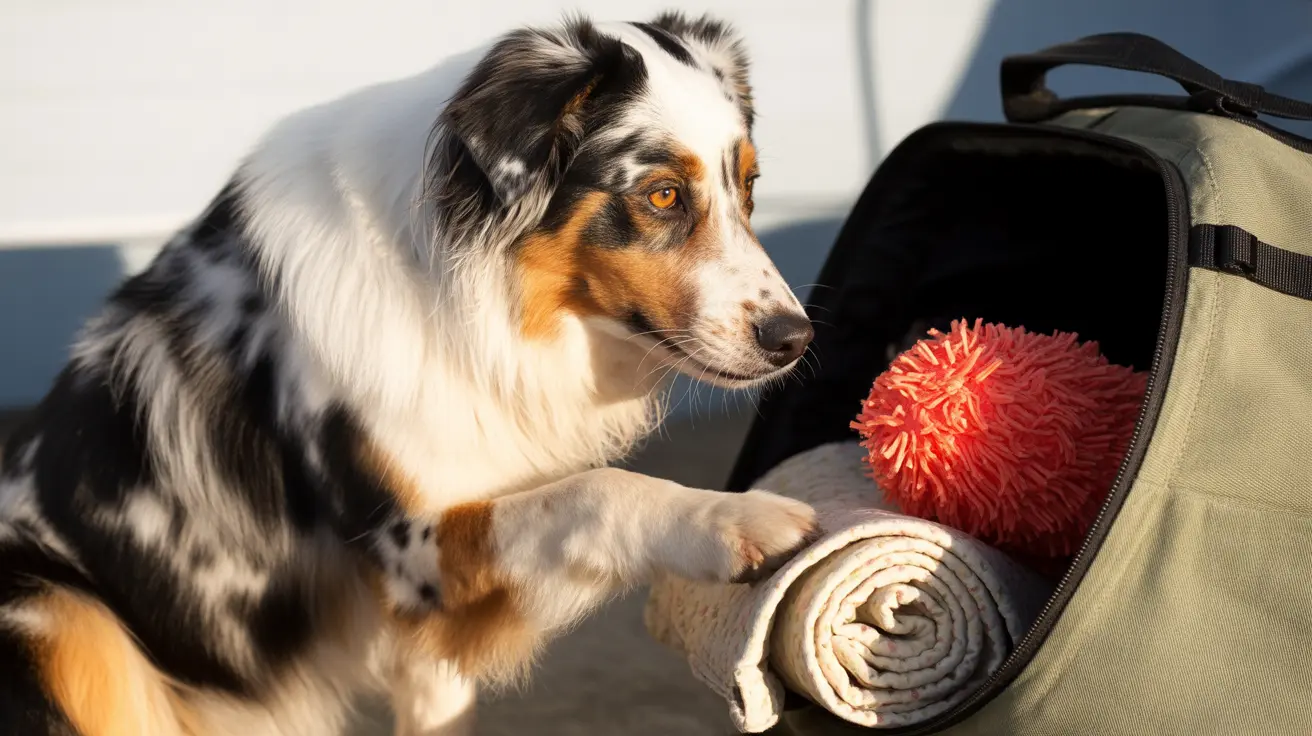The Ultimate Pre-Trip Checklist for Traveling with Your Dog: Essential Safety and Preparation Guide
Traveling with your beloved canine companion can create unforgettable memories, but proper preparation is crucial for ensuring your dog's safety, comfort, and compliance with travel regulations. Whether you're planning a weekend getaway or an extended holiday, having a comprehensive pre-trip checklist for traveling with your dog will help you avoid common pitfalls and create a stress-free experience for both you and your furry friend.
From essential documentation to packing the right supplies, this guide covers everything you need to know before embarking on your adventure. We'll explore critical safety measures, legal requirements, and practical tips that will transform your travel experience from potentially stressful to thoroughly enjoyable.
Essential Documentation and Legal Requirements
Before you even think about packing toys and treats, ensuring you have the proper documentation is the foundation of responsible pet travel. The most critical step in your pre-trip checklist for traveling with your dog involves securing proper identification and meeting legal requirements for your destination.
Microchipping and Registration Services
Registering your dog with a service like Tasso e.V. and implanting a microchip is absolutely crucial for identification and quick recovery if your dog gets lost during travel. This permanent form of identification provides peace of mind in unfamiliar environments where your dog might become disoriented or scared.
The microchip procedure is quick and relatively painless, similar to a vaccination injection. Once implanted, ensure you update your registration information before travel, including your temporary contact details at your destination. Keep the microchip number and monitoring company contact information easily accessible in your travel documents.
EU Pet Passport and Vaccination Requirements
For travel within Europe, carrying a valid EU pet passport with up-to-date vaccinations and microchip identification is mandatory. Tattoos alone are no longer accepted as valid identification. Your pet passport must include current rabies vaccination records, and depending on your destination, additional vaccinations may be required.
Consult with your veterinarian at least 4-6 weeks before departure to ensure all vaccinations are current and to discuss any destination-specific health requirements. Some countries may require additional protection against diseases prevalent in certain regions.
Pre-Departure Health and Safety Preparations
Veterinary Consultation and Health Check
Schedule a comprehensive veterinary consultation as part of your pre-trip checklist for traveling with your dog. This visit should include updating vaccinations, discussing preventive medications for your destination, and ensuring your dog is physically fit for travel. Your veterinarian can also provide advice on managing travel anxiety and recommend calming strategies if your dog is prone to stress.
During this consultation, request a list of local veterinary offices and emergency clinics at your destination. Having this information readily available can be invaluable in case of emergencies.
Breed-Specific Regulations Research
Different countries and regions have varying restrictions on specific dog breeds. Research breed-specific regulations for your destination well in advance, as some areas may have quarantine requirements or outright restrictions. This research should be completed months before travel to allow time for any necessary preparations or alternative planning.
Physical and Mental Preparation
Acclimate your dog to traveling gradually through short practice trips. Start with brief car rides and gradually extend the duration to help your dog become comfortable with the travel experience. Use safety restrictions like pet carriers or seatbelt harnesses during these practice sessions to familiarize your dog with proper travel restraints.
Complete Packing Checklist
Essential Documents and Emergency Information
Create a dedicated folder containing all necessary paperwork. Include your pet passport, vaccination records, insurance information, and a recent photo of your dog. Pack the microchip number and monitoring company contact details, along with a notebook containing emergency numbers including your veterinarian, emergency veterinary clinics, poison control, and local contacts at your destination.
Food and Water Essentials
Pack sufficient food plus extra to account for potential delays or extended stays. Store food preferably in a roll-top shoe bag to maintain freshness and prevent spills. Avoid feeding your dog shortly before a long car trip to prevent nausea; instead, feed 4-6 hours before departure and after arrival at your destination.
Bring extra water for hydration and cleanup, along with food and water bowls. Consider travel versions that are collapsible or easily portable.
Safety and Containment Equipment
Pack an extra collar and leash, as keeping your dog leashed during travel breaks and the first days at your holiday destination is essential to prevent escape due to nervousness in unfamiliar environments. Include a long line for areas where extended freedom is safe, and always check local leash laws for your destination.
Ensure you have appropriate containment equipment such as crates for vehicle travel or airline-approved carriers for air travel. A seatbelt harness is essential for car safety, while a foldable travel crate provides familiar comfort at your destination.
Comprehensive First Aid and Health Kit
A well-stocked travel first aid kit is an essential component of your pre-trip checklist for traveling with your dog. Start with a human first aid kit and add canine-specific items including a canine first aid manual, gauze and non-stick bandages, adhesive tape, and cotton balls.
Include hydrogen peroxide, antibiotic spray or ointment, and milk of magnesia (dosed according to veterinary advice). Pack a digital thermometer, scissors, tweezers for tick and splinter removal, and a magnifying glass for detailed examinations. Don't forget soap and water for wound disinfection, along with a soft muzzle for emergency situations.
Comfort and Enrichment Items
Familiar Comfort Objects
Bring familiar items for comfort such as your dog's favorite blankets, bedding, or toys. These familiar-smelling items help reduce anxiety and provide emotional support in new environments. Pack both favorite toys and some new ones to provide mental stimulation during the journey and at your destination.
Entertainment and Mental Stimulation
Include enrichment toys like chew toys and feeder puzzles to keep your dog occupied during travel and downtime. Treats serve dual purposes for training and positive reinforcement, especially useful for encouraging good behavior in new situations.
Destination-Specific Preparations
Accommodation Confirmation
Confirm pet admission at your chosen accommodation well in advance. Many pet-friendly establishments have specific policies, additional fees, or restrictions that you'll need to understand before arrival. Make dog-friendly travel arrangements by booking accommodations and destinations that genuinely welcome pets.
Climate and Activity Considerations
Pack according to your destination's climate and planned activities. For camping and outdoor adventures, add items like dog boots for hiking, rain jackets for short-haired breeds, and LED collar lights for night visibility. If water activities are planned, include a life jacket for your dog's safety.
Managing Travel Anxiety and Stress
Many dogs experience anxiety when traveling to unfamiliar places. Prepare calming strategies including familiar bedding, favorite toys, and potentially natural calming aids recommended by your veterinarian. Practice crate training if your dog will be confined during travel, making the crate a positive, comfortable space.
Plan regular rest stops every 2-3 hours during road trips for exercise and bathroom breaks. This helps prevent restlessness and provides opportunities for your dog to relieve stress through physical activity.
Transportation-Specific Requirements
Air Travel Preparations
For air travel, use airline-approved soft-sided carriers for small dogs traveling in-cabin, and durable crates for cargo travel. Ensure the crate complies with specific airline regulations, as requirements can vary significantly between carriers. Pack bowls that attach to the crate, absorbent mats, and a familiar-smelling item for comfort.
Road Trip Essentials
Confine your dog safely during car travel with appropriate crates or harnesses. Pack vehicle supplies like seat covers and storage bins to organize your dog's belongings and protect your car's interior. Include cleaning supplies such as paper towels and dog wipes for quick cleanups.
Frequently Asked Questions
How far in advance should I start preparing for travel with my dog?
Begin preparations at least 4-6 weeks before your departure date. This timeframe allows for veterinary consultations, vaccination updates, documentation processing, and gradual acclimation to travel through practice trips.
What should I do if my dog gets anxious during travel?
Keep your dog leashed and provide familiar comfort items like blankets or favorite toys. Maintain a calm demeanor yourself, as dogs often mirror their owner's energy. Consider natural calming aids recommended by your veterinarian, and ensure regular breaks for exercise and stress relief.
Is a microchip really necessary for travel?
Yes, microchipping is crucial for pet travel and often legally required. It provides permanent identification that cannot be lost like collar tags, making it essential for quick recovery if your dog becomes separated from you in an unfamiliar location.
How much extra food should I pack?
Pack at least 25% more food than you typically need for the duration of your trip. This accounts for potential delays, extended stays, or changes in your dog's appetite due to increased activity or stress.
What's the most important item in a dog travel first aid kit?
While all items are important, tweezers for tick removal and a canine first aid manual are particularly crucial. Ticks can transmit diseases quickly, and having reference material helps you respond appropriately to various health situations when veterinary care isn't immediately available.
Should I feed my dog before a long car journey?
No, avoid feeding your dog shortly before a long car trip to prevent nausea and car sickness. Feed your dog 4-6 hours before departure, and plan to feed again after reaching your destination.
How often should I stop during road trips with my dog?
Plan rest stops every 2-3 hours to allow your dog to exercise, relieve themselves, and reduce travel stress. These breaks are essential for your dog's physical comfort and mental well-being during extended travel.
Conclusion
Following a comprehensive pre-trip checklist for traveling with your dog ensures a safe, enjoyable experience for both you and your canine companion. From essential documentation and health preparations to packing the right supplies and managing travel anxiety, thorough preparation is the key to successful pet travel. Remember that every dog is different, so tailor these recommendations to your pet's specific needs, temperament, and health requirements.
By taking the time to prepare properly, you're not just ensuring compliance with travel regulations—you're creating the foundation for memorable adventures with your beloved four-legged family member. Safe travels, and enjoy exploring the world together!





